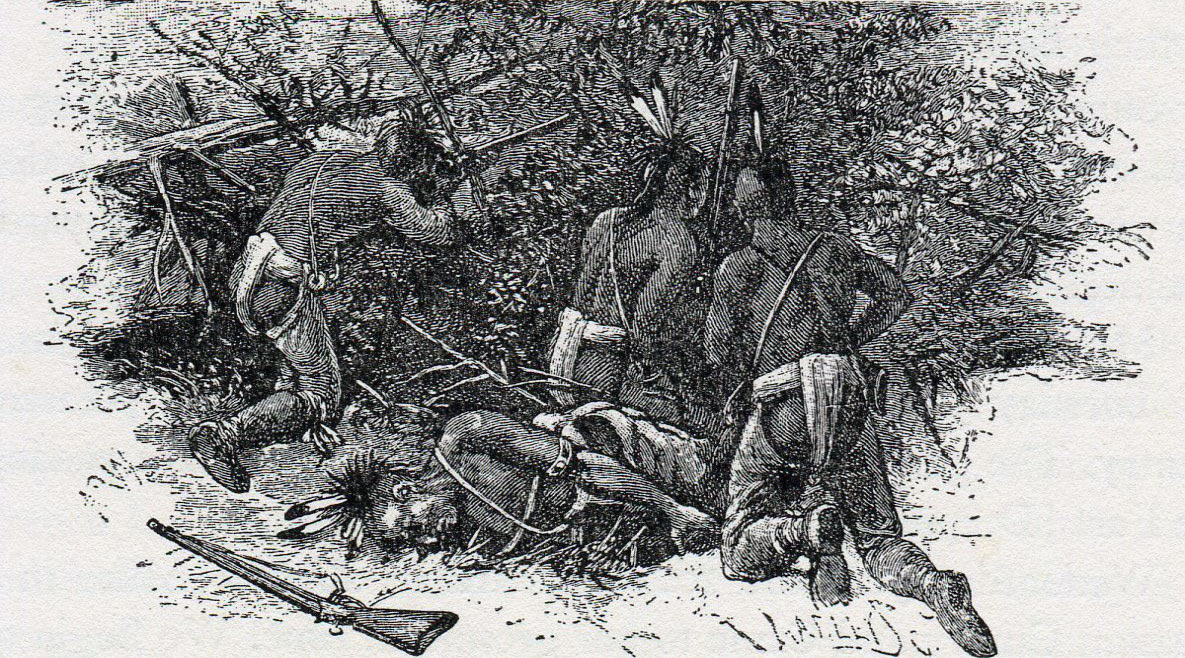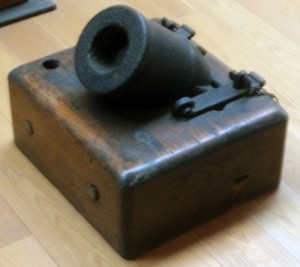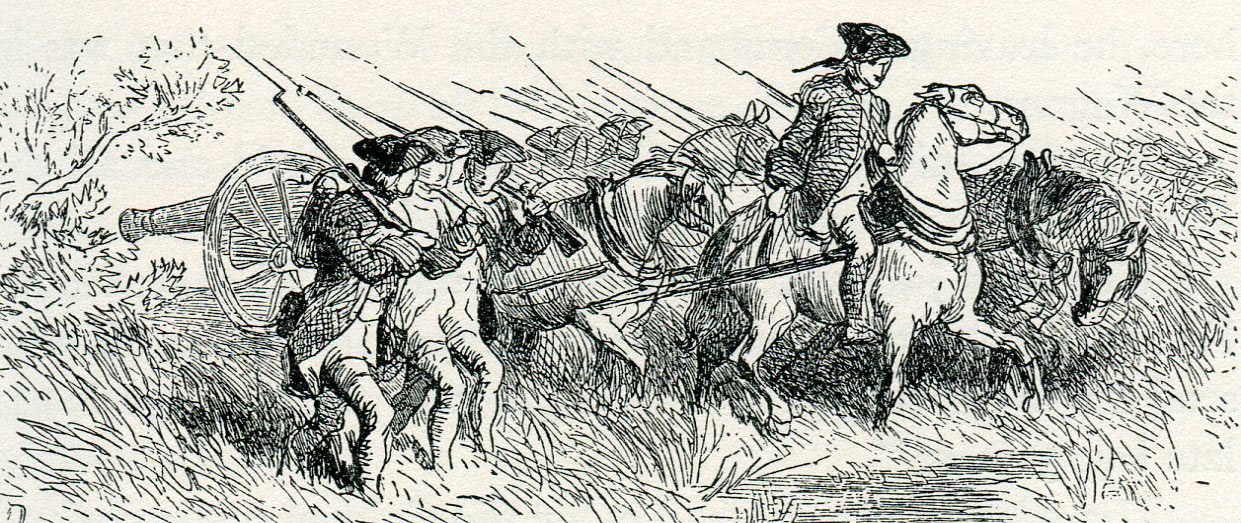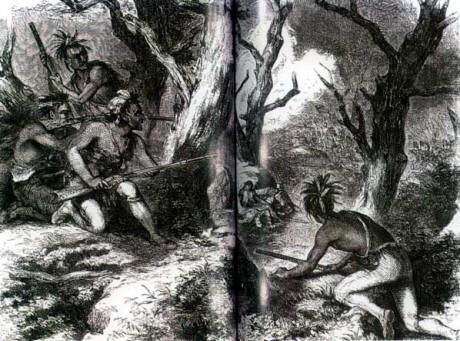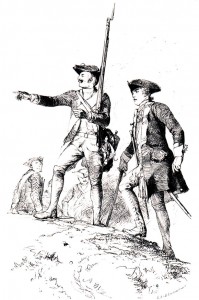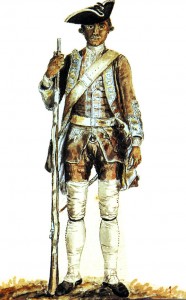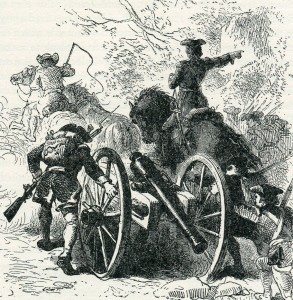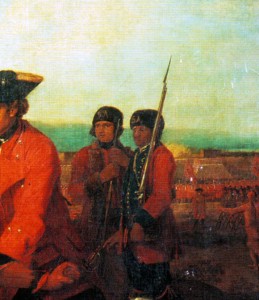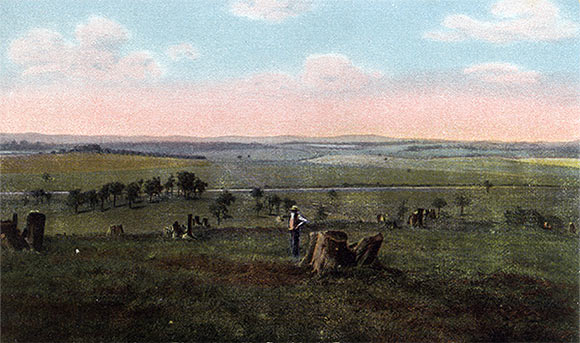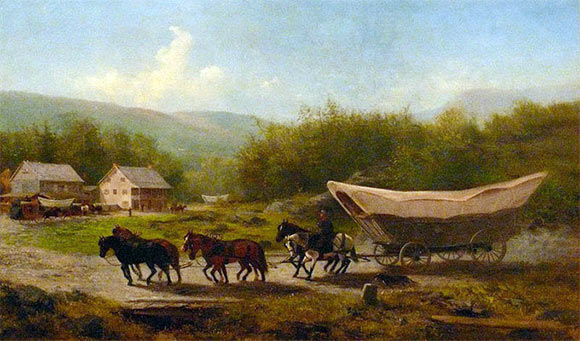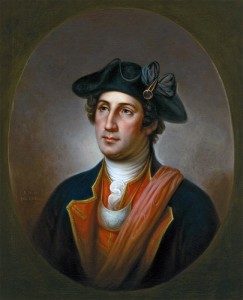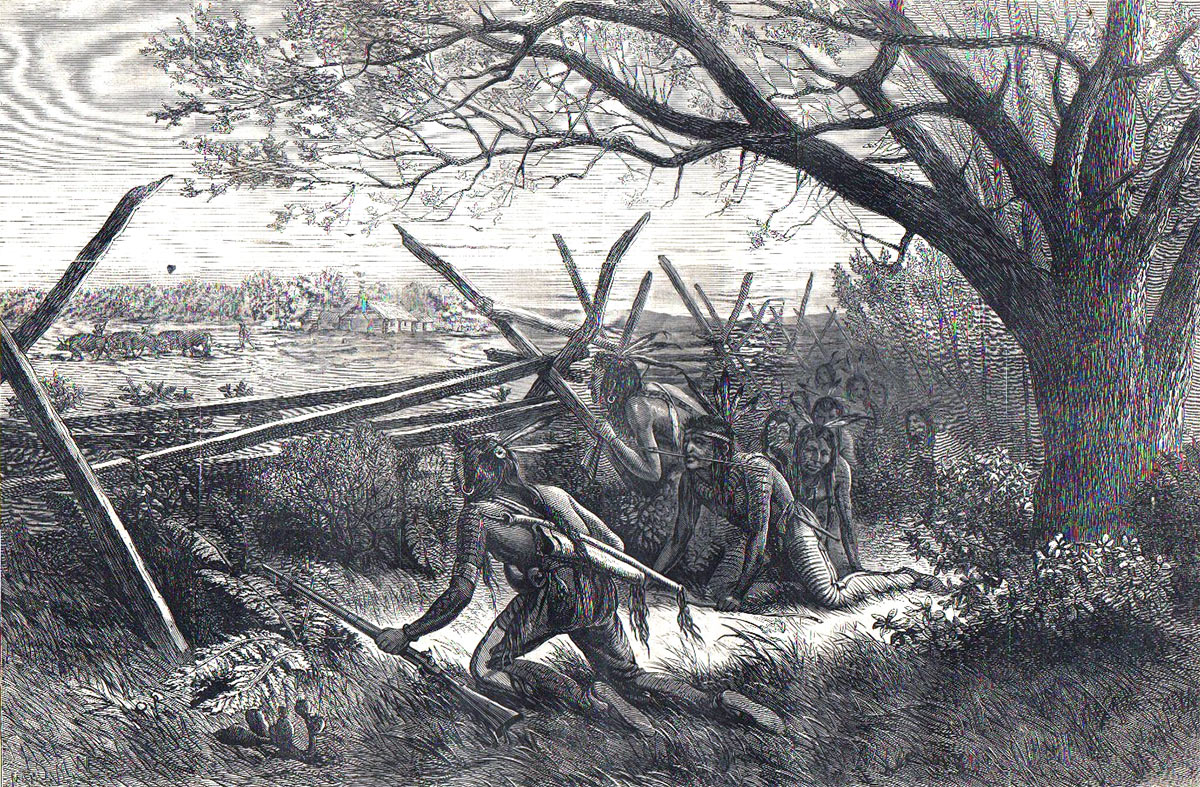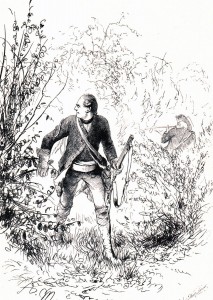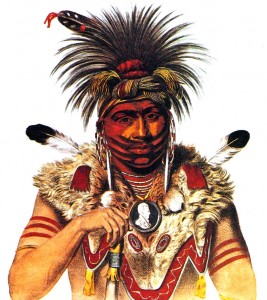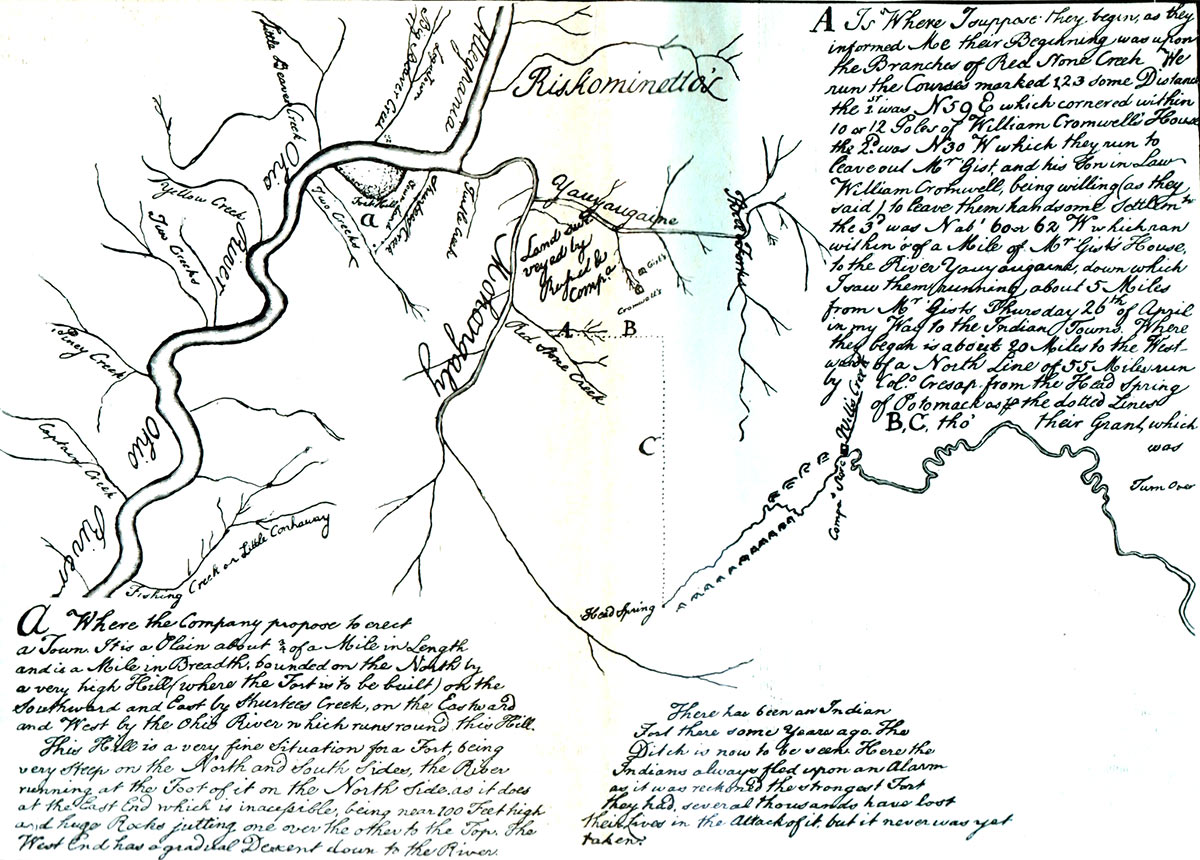The account of General Braddock’s expedition to Fort Duquesne in 1755:
Part 9: Braddock’s army’s march from Little Meadows to the Monongahela River.
The previous section on Braddock’s defeat on the Monongahela in 1755 is Part 8: Braddock’s army’s march from Fort Cumberland to Little Meadows May to June 1755.
The next section on Braddock’s defeat on the Monongahela in 1755 is Part 10: Braddock’s final battle on 9th July 1755.
To the French and Indian War index
In the days up to Tuesday 17th June 1755 General Braddock’s army assembled in the Camp at Little Meadows, 20 miles from Fort Cumberland on Will’s Creek. There remained 93 ½ miles to go to reach the French Fort DuQuesne at the Ohio Forks. The first 3 sections of the march had proved difficult, with many of the wagons damaged in the steep climbs both up and down. The army was slowed by building a road along the line of the Indian trail known as ‘Nemacolin’s’, cutting down trees and undergrowth, blasting rocks and bridging streams and areas of swamp.
There were insufficient wagons and, particularly, insufficient horses to haul the wagons and carry supplies. The horses were weak and ill – favoured.
The army was short of provisions and had little if anything in the way of fresh vegetables or fruit. The soldiers’ diet was largely salt meat from old navy casks several years old, flour at times and some game, when it was shot; bear, snake and deer.
Braddock made the decision to divide his force. He would press on with the best elements carrying sufficient supplies, leaving Colonel Dunbar commanding the remainder of the army to follow him at a slower pace with the rest of the stores. Braddock took the best horses leaving Dunbar with so few that he had to bring his wagons forward in relays.
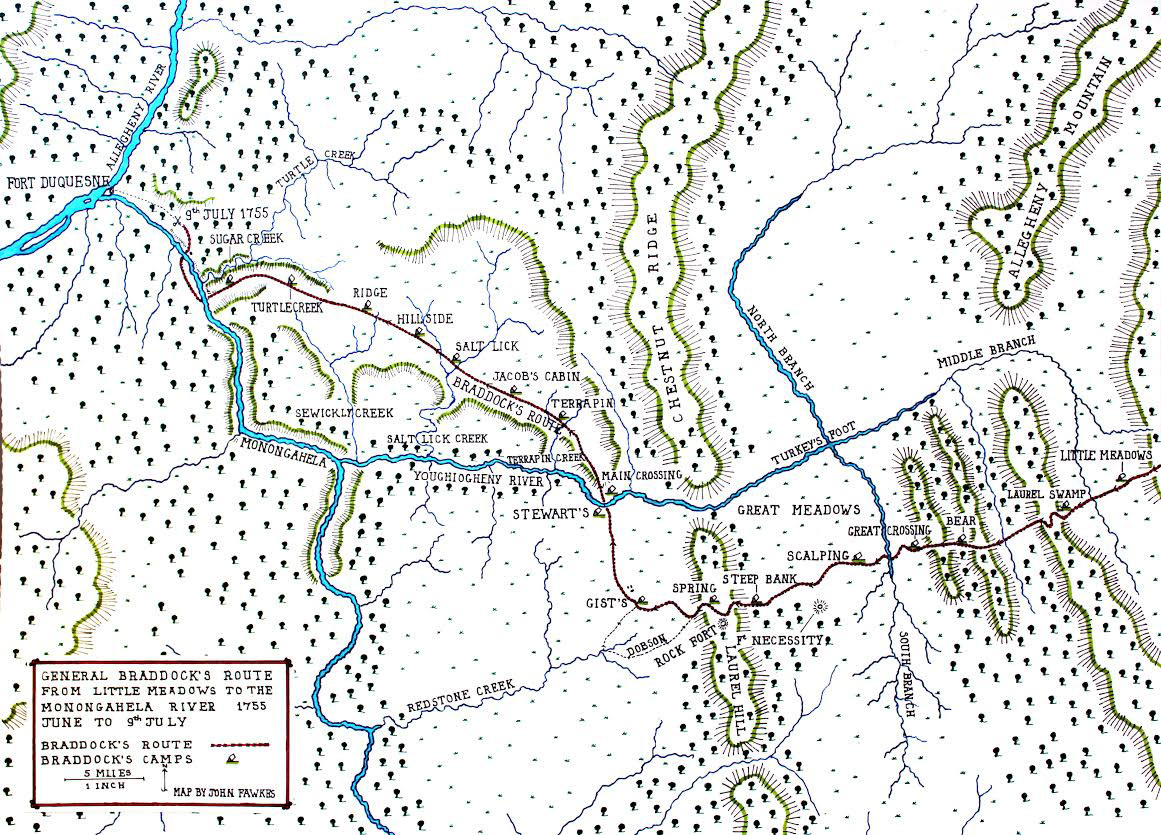
The route of General Braddock’s army’s march from Little Meadows to the scene of the battle by the Monongahela River on 9th July 1755
Tuesday 17th June 1755 at Little Meadows Camp:
The Officer recorded: “… The General finding that such a number of carriages delayed our march very much he was resolved to march forward with 1000 men. Accordingly a disposition was made immediately: 700 men of the old standers were picked out of the 2 regiments, 1 company of carpenters and 2 of rangers; 4 twelve pounders, 2 six pounders, 4 howitzers and 3 coehorns with 70 rounds for each and between 30 & 40 days provisions for the men so that the carriages did not exceed 50.”
Braddock’s orders directed: “Detachment to march tomorrow: 1 field officer 2 captains 6 subalterns 12 sergeants and 150 rank and file of the 2 regiments. Gates’ company, Wagoner’s and Peyrouney’s companies. Lieutenant Colonel Gage to command.
Detachment to march on Thursday morning at 4am: 1 colonel, 1 lieutenant colonel 1 major the 2 oldest grenadier companies, 5 captains, 20 subalterns, 22 sergeants and 550 rank and file of the 2 regiments. Colonel Halkett, Lieutenant Colonel Burton and Major Sparkes.
The King’s colour of the 44th and the 2nd colour of the 48th. The men with these detachments to be taken from those who landed from Ireland.
Captains and subalterns: Gage’s detachment 44th: Captain Beckwith Lieutenants Treby Sittler Ens Clarke. 48th: Captain Morris Lieutenants Harsard Barbutt and Ensign Dunbar. Halkett’s: 44th Captains Hobson and Githius Lieutenants Halkett, Bailey Pottinger Simpson Lock Kennedy Townsend Ensigns Nortlow Pennington Preston 48th: Captains Dobson Cholmley Bowyer Lieutenants Walsom Hathorn Edmonstone Cope Brierton Hurt Gladwin Ensigns Cowart Harrison Crowe McMullen. Surgeon’s Mate of 48th.
Rutherford’s and Stephens Cos march tomorrow and return to camp at night.
1 corporal and 4 light horse with Colonel Gage’s.
Detachment of seamen and Captain Stuart 1 subaltern and 18 light horse march on Thursday.
Lieutenant Buchanan of the artillery to march with the two guns tomorrow and Captain Smith and Lieutenant McLeod to march with Thursday detachment. Men to be completed to 24 rounds.”
Wednesday 18th June 1755: Fourth Stage of the March, from Little Meadows to Laurel Camp:
Engineer Gordon’s entry: From Little Meadows to Laurel Camp – 4 miles – A little blowing digging and bridging, a great deal of cutting – route: 3 ½ miles very good, ½ mile very stoney and rough – camp: bad in all respects.
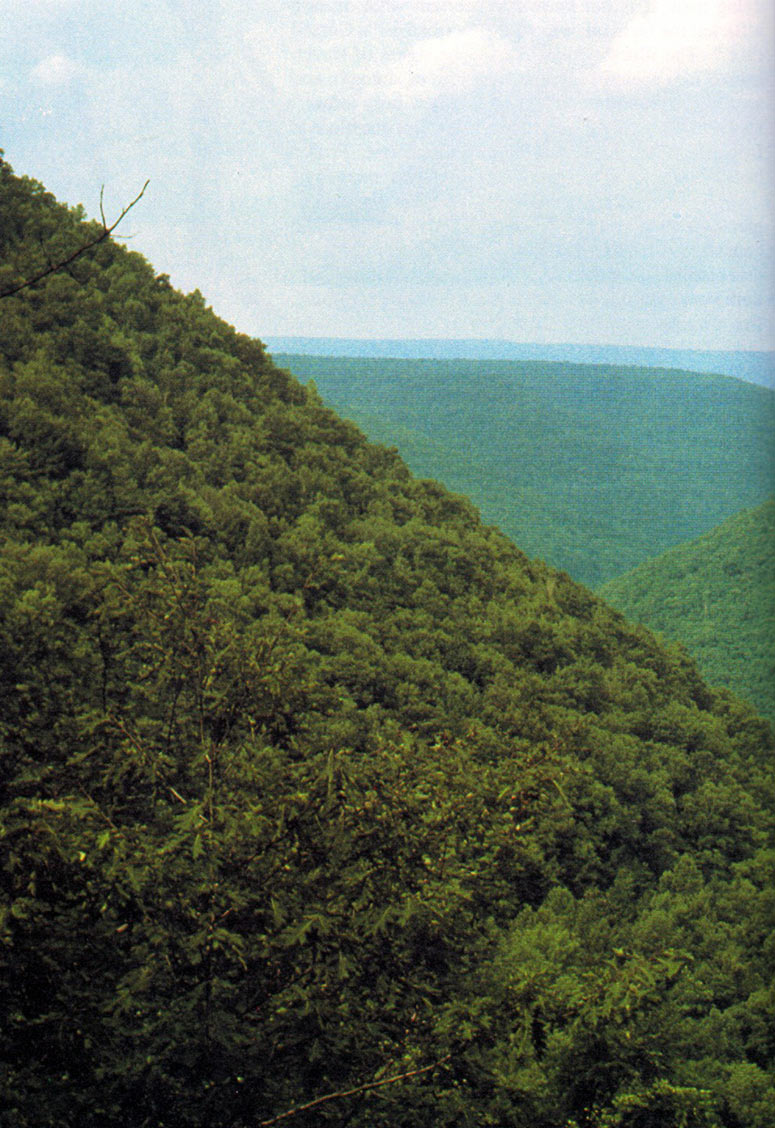
The Allegheny Mountains, through which General Braddock’s army marched in June 1755 to reach the Monongahela River
Captain Cholmley’s batman recorded: “500 men march out for Great Meadows. 1,000 to follow tomorrow…… 2 youngest grenadier companies to remain. All women but 2 per company ordered to stay or go to Ft Cumberland.”
Captain Orme recorded: “Detachment of field officer with 400 men and the Quarter Master General marched to cut the road to the Little Crossing taking two 6 pounders, 3 waggons of tools and 35 day’s provisions on carrying horses.”
Halkett’s order book directed: “Detachment to march tomorrow at 4am to have 2 days provisions of beef or pork but no flour.”
Thursday 19th June 1755:
The Officer recorded: “Everything being in readiness we marched forwards and reached about 8 miles. Immediately on coming to our ground we were alarmed by some Indians who were sent to spy into our motions. The reason for this alarm was Monacatotha being out in advance the day before was met by 70 Indians and some French who bound him and were going to kill him but an Indian of his own nation entreated that he might have his liberty. They questioned him about our numbers and artillery and were excessively surprised at his account. The French had endeavoured to persuade the Indians that it was impossible to march artillery through such a country and it was false. The French sent 5 Indians to reconnoiter who met some of ours who told them to stop a little. They ran away saying the French should come themselves next time. This alarm was made general but everything was soon quiet.”
Captain Orme recorded: “General marched out with detachment of 1 colonel, 1 lieutenant colonel, 1 major, 2 eldest grenadier companies and 500 rank and file; the party of seamen and 18 light horse, 4 howitzers with 50 rounds each, four 12 pounders with 80 rounds each and 100 rounds for each man and 1 wagon with Indian presents; in all 30 carriages. Howitzers had 9 horses each, 12 pounders 7 and wagons 6. Also 35 day’s provisions on horses. Indians marched with advanced party. Monocatootha captured and tied to a tree. Crossed Little Crossing (Castleman River). 80 yards over and knee deep.”
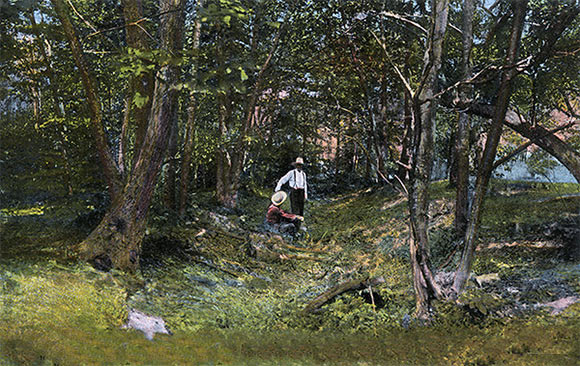
The scene near to Laurel Camp at a later date
“After marching 4 miles from Little Meadows came up with rear of advanced party cutting travers road over an immense mountain could not be finished until next day. On coming to ground guides ran in with report of great body of enemy advancing to attack. ADC sent to investigate found Lieutenant Colonel Gage in possession of top of mountain but no enemy. Indians had discovered large number of tracks near the advanced party. Gage 2 hours under arms and sent parties to scour the neighbouring woods. Then proceeded with work leaving parties to secure the heights and camped there that night. General ordered a captain and 100 men to move forward early in the morning and secure the place when advanced party moves out till general passes with artillery and baggage. Every field officer had a light horseman by whom to inform the general of accidents, stops or delays in their respective parts of the line of march.”
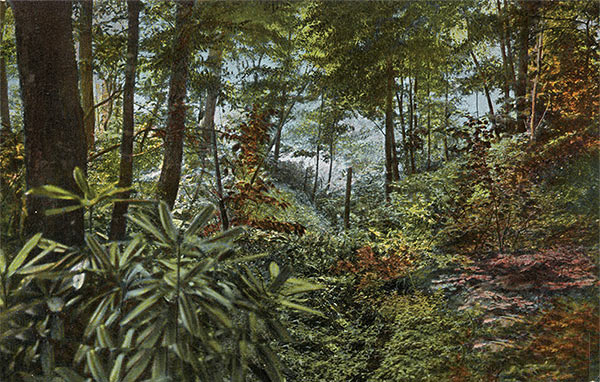
Scene of Gage’s search at a later date: Death of General Edward Braddock on the Monongahela River on 9th July 1755 in the French and Indian War
“Halted in camp on west side of Little Crossing 2 days, having to cut road in the side of the mountain and some swamps to make passable.”
Friday 20th June 1755:Fifth Stage of the March, from Laurel Camp to Bear Camp:
Engineer Gordon’s entry: From Laurel Camp to Bear Camp – 7 miles – work on road: great deal of cutting and digging, and a few bridges – route ½ mile in steep turnings, ½ mile good, 2 miles very rough and stoney, 4 miles tolerable – camp open, but good in all other respects
The Officer recorded: “General at 3am and we marched at 5. Road stony and some hills but marched 8 miles. The huntsmen got us venison almost every day, the soldiers and batmen begun to find themselves on short allowance; the road not being cleared we were obliged to halt there till the 23rd.”
Saturday 21st June 1755:
Captain Cholmley’s batman recorded: “Halt. Working party to cut road up large hill with covering party. Advance piquet in front of the line. In the night sentry fired at two men which alarmed the camp.”
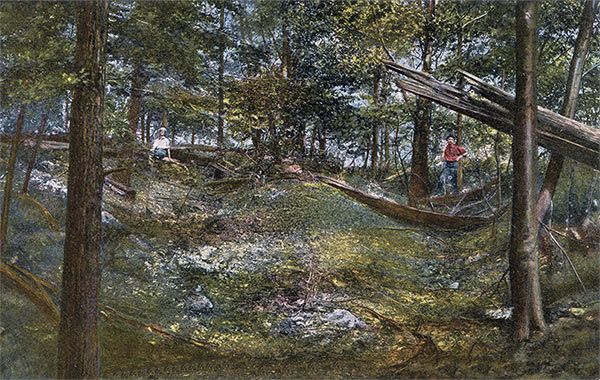
The mountain between Bear Camp and Middle Crossing at a later date
Sunday 22nd June 1755:
Captain Cholmley’s batman recorded: “Halt. Advance party marched to the Great Crossing. Rec’d 2 days provisions.”
Halkett’s orders at Bear Camp directed: “The men upon the advanced picquet to be loaded and none but them.”
Monday 23rd June 1755: Sixth Stage of the March, from Bear Camp to Great Crossing:
Engineer Gordon’s entry: Bear Camp to Middle Crossing (Great Crossing) – 8 miles – A great deal of cutting and digging, and a few bridges – route: 3 miles tolerable with a few hard pinches, the ridge ½ mile up in zigzags, 2 miles stoney, 2 ½ miles in a defile – camp: Open, dry, tolerable feeding, water bad.
Captain Cholmley’s batman recorded: “March 8 miles drove many Indians before us.”
Captain Orme recorded: “Marched from Bear Camp to Squaw’s Fort (Squaw’s Fort was situated at the Great Crossing) 6 miles of very bad road. 3 Mohawk Indians came to the general pretending friendship. Said reinforcements come to the French fort and more expected. Very little provision at the fort. Supplies interrupted by the dryness of the River aux Boeufs (French Creek). Given presents but left that night with one of our Indians.”
The Officer recorded: “General beat at 5am and we marched to within a mile of the Youghoigheny.”
Halkett’s orders directed: “General tomorrow at 6am the assembly half an hour later and march immediately. General Braddock’s order that no fires lit within 150 yards of the carriages.”
Tuesday 24th June 1755: Seventh Stage of the March, from Great Crossing to Scalping Camp:
Engineer Gordon’s entry: Middle Crossing (Great Crossing) to Scalping Camp – 7 miles – Digging, blowing, bridging, a great deal of cutting; chiefly old timber – route: Swampy for a mile, ¾ mile uphill rough and steep, ½ mile good, a steep hill, 1 ½ mile rough, the rest tolerable – camp: Open, dry, indifferent feeding, water bad.
Captain Cholmley’s batman recorded: “Marched 10 miles drove many Indians before us. 1 Indian deserted. Lay 2 hours after upon our arms.”
Captain Orme recorded: “Marched at 5am and passed Great Crossing 100 yards wide and 3 feet deep with a very strong current. Discovered abandoned Indian camp said to be for 170. Indians had stripped and painted some trees with threats and bravadoes. Marched 6 miles and at night joined the 2 detachments.”
The Officer recorded: “We crossed early in the morning. The crossing of this river was extremely beautiful and afforded a pleasant prospect. It undoubtedly appeared to us much more so having had nothing but a continued thicket to march through since our first setting out. On our march the guides imagined they saw some Indians frequently lurking round our line which we had reason afterwards to think true. A wagoner going out next morning to bring in his horses was surprised by a party of Indians who shot him in 4 places and his horse in the neck. Died after some days. The same morning 4 people going out to look after their horses were killed and scalped. One of the guides shot an Indian, a quantity of blood on the ground for 100 yards found a gun and a newly buried place.”
Halkett’s orders from 1st Camp from the Great Crossing directed: “Troops to receive as soon as they come to their ground 1 days bread and 1 days flour and half a pint of beans. General Braddock’s order that no fires lit within 100 yards of the carriages and this to be a standing order. Before the men of the advance piquet turns out in the morning they are to examine their pans and supply any deficiency with fresh powder. General at 7am, the assembly at 8 and march immediately.”
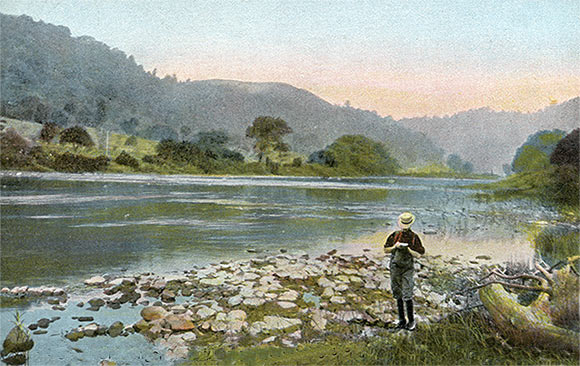
Great Crossing on the Youghougheny at a later date
Wednesday 25th June 1755: Eighth Stage of the March, from Scalping Camp to Steep Bank Camp:
Engineer Gordon’s entry: Scalping Camp to Steep Bank Camp – 7 miles – Cutting old and standing timber, a little bridging and digging – route: All along pretty good, accepting a steep bank in the rear of the camp – camp: Pretty secure, feeding distant, water bad.
On this day’s march the army passed the site of Fort Necessity.
Captain Cholmley’s batman recorded: “Alarmed at 4am by Indians firing at our wagoners fetching their horses. Wounded two and scalped 1 a servant of Major Halkett. Marched 8 miles across Great Meadows, mile long and 200 yards wide. Killed a French Indian.”
The Officer recorded: “We marched about 2 miles the other side of the Great Meadows. Expected
opposition here. Many human bones and some broken swivels at Fort Necessity.”
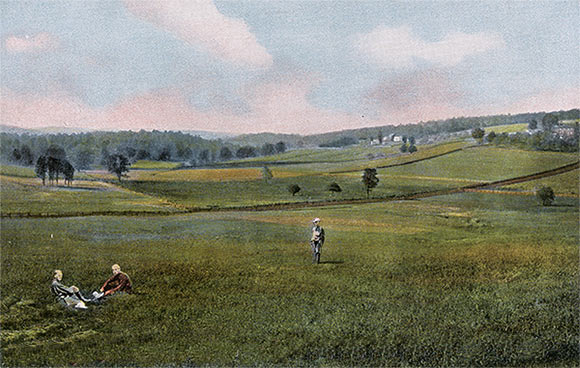
Great Meadows and the site of Fort Necessity at a later date
Halkett’s orders at Steep Bank Camp directed: “1 captain 2 subalterns 2 sergeants and 50 rank & file of the line with 1 sergeant and 8 light horse to parade immediately at the front gun. 1 subaltern and 20 of this detachment to be detached to the rear and some on each side of the roads and to bring to camp all stray horses. Parties not to be nearer than 100 yards of the line. Sergeants’ and corporals’ parties never nearer than 50 yards of their officers. His Excellency expects this order to be strictly complied with. Determined to put first officer under arrest that he finds negligent.”
Thursday 26th June 1755: Ninth Stage of the March, from Steep Bank Camp to Spring Camp:
Engineer Gordon’s entry: Steep Bank Camp to Spring Camp – 3 ½ miles – Cutting old and standing timber, a little bridging and digging – route: 2 miles tolerable but stoney, descent of the hill steep, the rest good – camp: Open, dry, indifferent feeding, fine water.
Captain Orme wrote: “Marched at 5am but only made 4 miles due to badness of road. At halting place found another Indian camp abandoned on approach fires still burning. Marked triumph on trees with scalps taken two days before and French had written names and “many insolent expressions”. Paper saying commanded by Sieur Normanville. Indian camp in very strong position on high rock with narrow steep ascent to the top and spring in the middle. At top of path to Monongahela and Redstone Creek.
Path by which French came to Fort Necessity. Tracks showed divided 1 to Fort DuQuesne and other to Redstone Creek. Captain, 4 subalterns and 90 volunteers and guides marched to Redstone Creek. Found some provisions and a bateau destroyed and rejoined at Gist’s plantation having seen no men.”
The last part of this entry relates to the dispatch of Captain Dobson’s party to Redstone Creek, following the trail of the Indians who had been most recently at this camp.
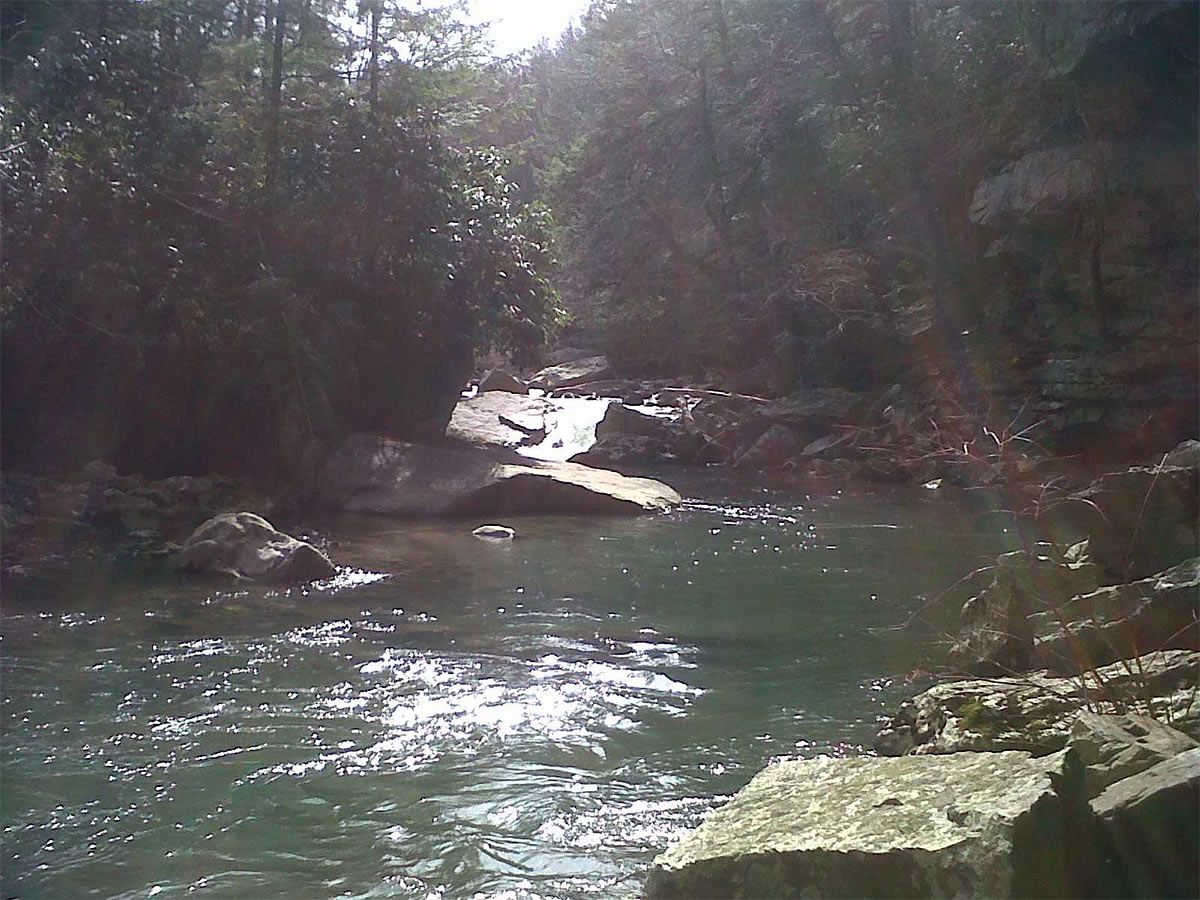
Redstone Creek, the scene of Captain Dobson’s patrol in pursuit of the Indians, leading to the discovery of an abandoned camp and a canoe
The Officer recorded: “We marched about 4 miles and crossed a very high and steep mountain. Our encampment was under a rocky hill where 150 or 200 French and Indians had encamped the night before. They had drawn many odd figures on the trees expressing with red paint, the scalps and prisoners they had taken with them. 3 French names wrote there: Rochefort, Chauraudray and Picauday. From this place Captain Dobson with 70 volunteers set out for Redstone Creek where a party of French and Indians had been all winter. They found nothing but a bateau and some canoes with some pieces of pork and beef which they burnt. At going they took a biscuit and a gill of rum each man on which they were obliged to live 48 hours.”
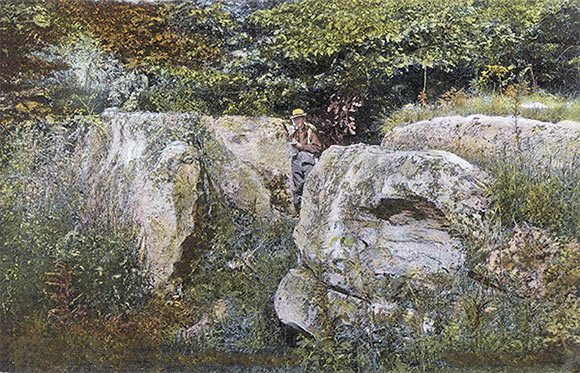
The scene of Spring Bank Camp at a later date
Halkett’s orders directed: “…….General tomorrow at 4am assemble at 5am and troops march immediately after. Picquets only to have blankets for out sentries. The line never to be turned out on any account whatever but by an order from the general or the field officer of the day or the commanding officer of each regiment. Any officer who turns out the line shall be cashiered non commissioned officer or soldier will receive 1,000 lashes. 5 pounds for an Indian scalp.
Troops immediately to receive 4 days flour, 2 days fish and 1 day’s pork which completes them to 30th incl.
The officers and soldiers of the 2 regiments on detachment with Sir John St Clair to be relieved tomorrow upon the troops coming to their ground. The general tomorrow at 5am assembly at 6 and march ½ hour after. A soldier falls sick his arms and accoutrements to be put in one of the covered wagons. Provisions to be delivered to the men as soon as possible after they come to their ground.”
Friday 27th June 1755: Tenth Stage of the March, from Spring Camp to Gist’s Plantation:
Engineer Gordon’s entry: Spring Camp to Gist’s Plantation – 8 miles – A great deal of cutting and digging, a few bridges – route: 2 miles pretty good, ½ mile steep, 3 miles rough and stoney, the rest somewhat soft – camp: Open, moist, good feeding, good water but muddy.
Gist’s Plantation was the site of the Ohio Company’s one attempt at settlement. See the entry in Part I. Braddock’s force was now out of the area of Mountains and Virgin Forests and the going became significantly easier.
Captain Cholmley’s batman recorded: “Marched 8 miles. Alarmed at midnight by Indians firing at sentries. 2 captains and 100 men out of camp 1 mile and lie there until general and then march in abreast to see if could surround them. Captain Cholmley took part. To no purpose.”
Captain Orme recorded: “Marched from Rock Fort to Gist’s plantation 6 miles road still mountainous and rocky. Here advanced detachment relieved and wagons and carrying horses joined us and men were to be victualled from us”.
The Officer recorded: “We marched to Guest’s plantation over a long and steep mountain our course to the East of the North. Here the mountains begin to diminish and a fine pleasant rich soil is seen.”
Halkett’s orders directed: “CAMP AT GUESTS HOUSE: Returns to be made of number of men in each unit. Sergeants to attend Mr Leslie tomorrow at 5am to receive a quantity of rum for each man which His Excellency is pleased to give the men in consideration of their good behaviour.
Capt Gates with a detachment of his company and 2 sergeants and 50 rank & file of the 2 regiments now encamped with Capt Polson’s company of carpenters Capt Waggoners and Capt Perronee’s companies of rangers to parade tomorrow at daybreak at the head of the front gun to march to Sir John St Clair’s camp and put themselves under his command. The whole detachment of the 2 regiments now under Sir John St Clair to join their respective corps tomorrow at 5am exc Lt Littler of 44th and Lt Hansard of 48th. The wagons and horses Sir John leaves behind to fall into our line and be disposed of in the same order of march. Troops to hold themselves in readiness to march at half an hours warning.”
Saturday 28th June 1755: Eleventh Stage of the March, from Gist’s Plantation to Stewart’s Camp (on South Bank of the Youghougheny River):
Engineer Gordon’s entry: Gist’s Plantation to Stewart Camp – 5 miles – A great deal of cutting and digging, a few bridges, chiefly old timber, several bridges – route: In general good, the soil rich and in many places soft and deep – camp: Secure, dry, indifferent feeding, water tolerable
Captain Cholmley’s batman recorded: “Marched 7 miles. The most terrible rain that ever happened. 7pm when reached ground. A captain and 80 soldiers went to hunt Indians. Travelled 80 miles and saw only a bear sitting in a Mulberry Tree and a fine boat in the river that could hold 20 and 1 man might carry it on his back.” (Captain Dobson’s party to Redstone Creek: it would seem that the batman heard about this expedition after Dobson’s return to the main army at Gist’s Plantation.)
The Officer recorded: “We marched within half a mile of the great crossing of the Youghiogheny over exceeding fine ground our course Northerly.”
Halkett’s orders directed: “CAMP ON THE YOUGHIOGHENY: 1 field officer 2 captains 4 subalterns and 150 men of the 2 regiments to parade immediately and remain on the ground. 1 subaltern and 40 men of the 2 regiments to parade at the same time for a rear guard.”
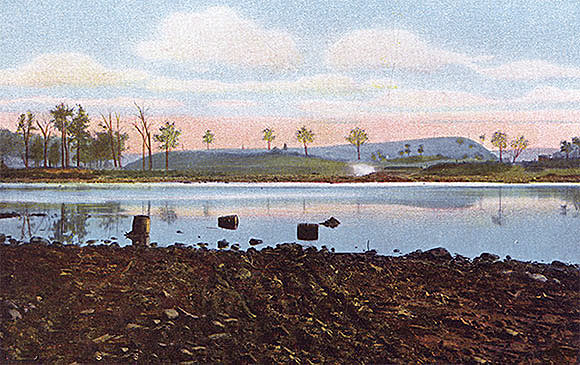
Stewart’s Crossing on the Youghougheny at a later date: Death of General Edward Braddock on the Monongahela River on 9th July 1755 in the French and Indian War
George Washington wrote a letter to his brother John Washington from Bear Camp, in which he stated: “Immediately upon our leaving the camp at George’s Creek the 14th Inst I was seized with violent fevers and pains in my head which continued with the lightest intermission until the 23rd following which I was relieved by the general absolutely ordering the physicians to give me Dr James’ powder which is the most excellent medicine in the world for it gave me immediate ease and removed my fevers and other complaints in 4 days time. My illness was too violent to suffer me to ride therefore I was indebted to a covered wagon for some part of my transport but even this I could not continue for the jolting was so great that I was left upon the road with a guard and necessaries to wait the arrival of Colonel Dunbar’s column which was 2 days behind.
In the letter which I wrote from George’s Creek I acquainted you that unless the number of wagons were retrenched and the carrying horses increased that we never should be able to see Duquesne: this, in 2 days afterwards which was about the time they got to the little Meadows with some of their Wagons and strongest teams, they themselves were convinced of it, for they found that beside the almost impossibility of getting the wagons along at all; that they had often a rear of 3 or 4 miles of wagons; and that the soldiers guarding them were so dispersed that if we had been attacked either in front, center or rear the part so attacked must have been cut off and totally dispersed before they could be properly sustained by any other corps.
At the little Meadows there was a second Council called, for there had been one before wherein it was represented to all the officers of the different corps the great necessity there was for horses and how laudable it would be to retrench their baggage and offer the spare horses for the public service. In order to encourage this I gave up my best horse, which I have never heard of since and took no more baggage than half my portmanteau would easily contain. It was also said that the number were to be lessened; but there was only from 210 or 12, to 200 which had no perceivable difference.
The general before they met in council asked my private opinion concerning the Expedition. I urged it in the warmest terms I was master of, to push on; if we even did it with a chosen detachment for that purpose, with the artillery and such other things as were absolutely necessary; leaving the baggage and other convoyes with the remainder of the army, to follow by slow and regular marches, which they might do safely, while we were advanced in front. As one reason to support this opinion, I informed the general if we could credit our intelligence, the French were weak at the forks but hourly expected reinforcements, which to my certain knowledge could not arrive with provisions or any supplies during the continuance of the drought as the Buffalo River down which is their only communication to Venango, must be as dry as we now find the great crossing of the Youghiogheny, which may be passed dry shod.
This was a scheme that took and it was determined that the general with 1,200 chosen men and officers of all the different corps, with the following Field Officers; viz: Sir Peter Halkett who acts as brigadier, Lt Col Gage, Lt Col Burton and Major Sparke, with such a certain number of wagons as the train would absolutely require, should march as soon as things could be got in readiness for them, which was completed, and we on March by the 19th, leaving Colonel Dunbar and Major Chapman, with the residue of the two regiments, companies, most of the women and in short every thing behind except such provisions and other necessaries as we took and carried upon horses.
We set out with less than 30 carriages (including all those that transported the Howitzers, 12 pounders and 6 pounders etc) and all of these strongly horsed; which was a prospect that conveyed the most infinite delight to me though I was excessively ill at the time. But this prospect was soon over turned and all my sanguine hopes brought very low when I found, that instead of pushing on with vigour, without regarding a little rough road, they were halting to level every mole hill and to erect bridges over every brook; by which means we were 4 days getting 12 miles; where I was left by the doctors advice and the general’s absolute order.”
Sunday 29th June 1755: Twelfth Stage of the March, from Stewart’s Camp (on South Side of the Youghougheny River) to Main Crossing (fording the Youghougheny River):
Engineer Gordon’s entry: Stewart Camp to Main Crossing – 2 miles – Digging, some cutting, one bridge – route: A steep bank in the front of the camp, uneven to the ford, ford rough, the rest good – camp: Open, dry, tolerable feeding, water good, very fine coal here
The Officer recorded: “We crossed the river without any opposition which was not expected and encamped on the other side, our course to the North.”
Captain Cholmley’s batman recorded: “Marched 4 miles. Pleasant country. Weeds hide me on the horse from seeing men 20 yards distant.”
Monday 30th June 1755:
Captain Cholmley’s batman recorded: “Halted and received provisions”.
Captain Orme recorded: “Crossed main body of Youghougheny 200 yards broad and 3 feet deep. Advanced guard passed and took post till artillery and baggage got over. Obliged to camp 1 mile on west side to cut a passage over a mountain. Did not march more than 2 miles. Part of the flour having been unavoidably damaged by severe rains, the general sent an order to Colonel Dunbar to forward to him with the utmost diligence one hundred carrying horses with flour and some beeves with an escort of a captain and one hundred men. Men’s arms all drawn and cleaned and four day’s provisions served to the men that they might prepare a quantity of bread and dress victuals to carry with them”.
The Officer recorded: “Remained in camp, the working party only advancing to clear the road for the next day’s march.”
Halkett’s orders directed: “CAMP AT THE CROSSING OF THE YOUGHIOGHENY: For the future the soldiers tents are always to be pitched in a single line facing outwards and no officer is to pitch his tent or have his picquet of horses in the front of the soldiers tents but always in the rear and that there may be sufficient room for that purpose it is His Excellency’s orders that as soon as the troops are come to their ground and the carriages closed up, that the commanding officers of each regiment order their several detachments to advance 25 paces from that part of the line of carriages which they separately cover and there pitch their tents. The officers upon the advance picquets and the sergeants and corporals that are detached from them are upon no account whatever to suffer any fires to be lighted to their front. The general to beat at 5am tomorrow and the assembly at 6 and the troops to march immediately after.”
Tuesday 1st July 1755: Thirteenth Stage of the March, from Main Crossing (on the Youghougheny) to Terrapin Camp:
Engineer Gordon’s entry: Main Crossing to Terrapin Camp – 7 miles – Chiefly cutting, some bridges – route: 4 miles somewhat stoney, the rest tolerable but in some places sloughy – camp: Open, dry, indifferent feeding, water distant
Captain Cholmley’s batman recorded: “Marched 9 miles in pleasant country. Gentlemen afraid we are passing the fort.”
Captain Orme recorded: “Marched 5 miles but no further due to a great swamp which required much work.”
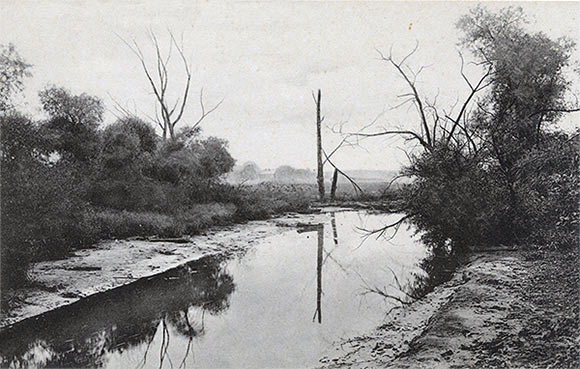
Jacob’s Creek in later times: the swamp referred to by Captain Orme was on the east side of the creek: Death of General Edward Braddock on the Monongahela River on 9th July 1755 in the French and Indian War
The Officer recorded: “We marched early over a very long and high ridge, the Youghiogheny running on each side of us. There was frequent found pieces of coal which when tried burned like pitch. This day’s march we went 8 or 9 miles, the soil good and tolerably level, course northwards.”
Halkett’s orders directed: “It is His Excellency’s orders that no tents are pitched nor any blankets carried for the parties that lie on the advance picquet upon any account whatever. When the troops come to their ground tomorrow 1 field officer 1 captain 3 subalterns and 100 rank & file from the 2 regiments to join the advance party and 1 of the comp of rangers now with the advance party to join our line and encamp in the rear. For the future all returns for provisions to be signed by commanding officers and give the names of all personnel. His Excellency is determined to punish anyone in breach.”
Wednesday 2nd July 1755: Fourteenth Stage of the March, from Terrapin Camp to Jacob’s Cabin Camp:
Engineer Gordon’s entry: Terrapin Camp to Jacobs Cabin – 5 miles – Bridging a swamp, digging a bank, cutting a great deal of old timber – route: in general good – camp: Open, dry, good feeding, fine water.
The Officer recorded: “We marched early about 3am and reached 6 miles to a placed called Jacobs Cabin. Course still to the Northward.”
Captain Cholmley’s batman recorded: “Marched 6 miles in pleasant country to ground in time. “We begin to be scarce in provisions in that we only receive ¾ pound of flour and ½ pound of bacon each day per man, the other provisions being so far behind and the wagons so loaded and wanting horses. They die so fast that when they march they cannot draw above half of the wagons so when they come to their ground they are obliged to send the horses back for the remainder of the wagons which delays them so that they cannot overtake us.”
Halkett’s orders directed: “CAMP AT JACOBS CABINS: General to beat directly. Capt Wagoner’s company is always to take the guard over the wagons of provisions and to detach 1 sergeant and six men as a rear guard.”
Thursday 3rd July 1755: Fifteenth Stage of the March, from Jacob’s Cabin Camp to Salt Lick Camp:
Engineer Gordon’s entry: Jacobs Cabin to Salt Lick – 4 miles – Several banks dugg, cutting and bridging – route: in general good – camp: Secure, dry, very good feeding, tolerable water.
Captain Cholmley’s batman recorded: “Marched 5 miles, very good roads but hilly.”
The Officer recorded: “We marched at 4 and got to Lick Creek, the ground in some parts a little uneven but mostly very good. Name from animal lick for Deer, Buffaloes and Bears. Day’s march was about 5 miles.”
Captain Orme recorded: “The swamp being repaired marched 6 miles to Salt Lick Creek. The Quarter Master General proposed to the general to halt and send back horses to bring up Dunbar’s det. Council of War held (Halkett, Gage, Burton, Sparks and Quarter Master General). Unanimous opinion not to stop.”
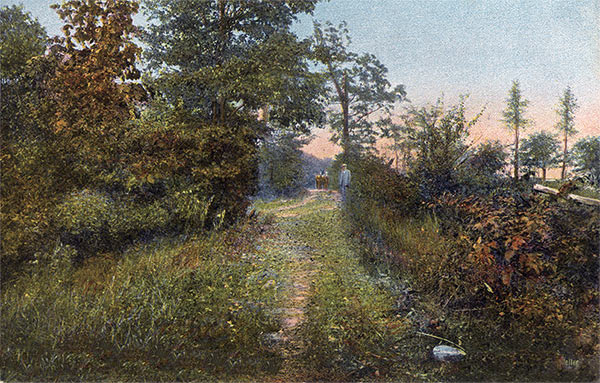
The route to Salt Lick Camp in later times.
Halkett’s orders directed: “CAMP AT THE DEERS’ LICK: The commanding officers of companies to review their men’s arms this evening at retreat beating and to see they are clean and put in the best order possible tomorrow morning. At assembly beating all the troops are to load their pieces. The sentries from the advance picquets are to be doubled not by an additional number of sentries but by planting 2 sentries at each post. The officers upon the advance picquets during the nighttime to have half their picquets constantly under arms with fixed bayonets and relieve them every two hours. The half that is relieved may lay down by their arms, but are not to be suffered to quit their picquets. The captains of the picquets to lie out at nights and when they are not going their visiting rounds they are to be found at the head of the centre picquet of that flank where they are appointed to visit.”
Friday 4th July 1755: Sixteenth Stage of the March, from Salt Lick Camp to Hillside Camp (Thicketty Run Camp):
Engineer Gordon’s entry: Salt Lick to Hillside – 3 miles – Some bridging and cutting, a little digging – route: In general good with a few hard pinches – camp: Open, dry, bad feeding, water indifferent.
Captain Cholmley’s batman recorded: “Marched 6 miles and came within 16 miles of Fort Du Cain.”
Captain Orme recorded: “Salt Lick Creek: Marched 6 miles to Thicketty-run. Country now less mountainous and rocky and woods rather more open consisting chiefly of white oak. 2 Indians prevailed upon to go for intelligence to the fort and also Gist, the general’s guide.”
This entry is one of only two references to Gist, presumably Christopher Gist the Ohio Company’s scout who conducted the reconnaissances of the Ohio Company’s land grant on the Ohio River. See Part I. Both the references to Gist appear in Orme’s journal.
The Officer recorded: “We marched at 3 and got about 6 miles. This day 2 of our Indians went to reconnoiter the French fort.”
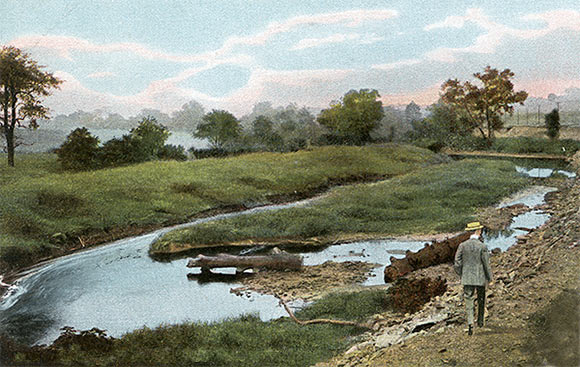
The Ford on Great Sewickley Creek, that the army crossed on 4th July 1755, in later days
Halkett’s orders directed: “CAMP AT THE THICKET RUN: When any advance sentry fires his piece in the night time the captain of the picquet for that flank from which the shot is fired is immediately to go a visiting round to that part of the picquet and to send word to the field officer the reason for the shots being fired. The drummers of the advance party to beat the pioneers march instead of the general. The detachment of 100 men from the 2 regiments that joined the advance party to be relieved this evening. Field officer for this detachment: Lieutenant Colonel Gage. Troops to halt tomorrow.”
At Fort Cumberland, Charlotte Browne recorded: “All greatly alarmed with the Indians scalping several families within 10 miles of us; one poor boy brought in with his scalp off, he lived 4 days. Several families left their homes and came to the fort for protection.”
Saturday 5th July 1755:
Captain Cholmley’s batman recorded: “Halted and received a fresh supply of bullocks from Colonel Dunbar.”
Captain Orme recorded: “Thickety-Run: At this camp the provisions from Colonel Dunbar with a detachment of a captain and one hundred men joined us, and we halted here one day”.
The Officer recorded: “We remained in camp except a reconnoitering party with Sir John St Clair and an engineer who returned the same evening. This day a party came in from Colonel Dunbar with 100 oxen and a large quantity of flour, a very seasonable supply having lived on salt provisions the whole time.”
Halkett’s orders directed: “THE CAMP NEAR THE THICKET RUN: The general to beat tomorrow at 6am. Monacatotha’s son will be interred this evening.”
Sunday 6th July 1755: Seventeenth Stage of the March, from Hill – side Camp (Thicketty Run Camp) to Ridge Camp (re-named Monacatotha Camp after the death of Monacatotha’s son, accidentally shot by troops):
Engineer Gordon’s entry: Hillside to Ridge Camp – 6 miles – Cutting through four thickets, and digging three banks – route: In general good, turned off Indian path to avoid long run – camp: Open, dry, bad feeding, water at a distance.
Captain Cholmley’s batman recorded: “Marched. Reconnaissance to Fort 2 Indians killed a Frenchman in a canoe. About 11am Indians attack our baggage on the march in the rear scalped a woman and a soldier.
Wounded 1 man in shoulder and began scalping another when rear guard came to his relief. About 1pm we started a parcel of French Indians. Our soldiers began to fire. Our Indians coming to assistance, killing 1 and wounding 2. Killed, Monocatootha’s son, carried in wagon and buried at camp. Marched 6 miles.”
The Officer recorded: “We marched early. At 10 the 2 Indians returned with a French scalp. Told us they saw men and provisions in canoes to the fort. French no change to the fort except moving flag to another bastion. No advanced post whatever. After we had marched about 6 miles we were alarmed by some Indians who fired on our right flank. This put the men in a good deal of confusion. However we returned the fire very briskly and obliged them to retire. At the beginning of the fire unluckily Monacatotha’s son shot by our own people. He had brought in the scalp that morning. When we halted we had him buried with all decency. Old Monacatotha who undoubtedly is a very good man was hardly able to support his loss. We sent a party immediately to pursue the Indians and traced blood a considerable way. They found 2 spears and some little things belonging to the Ottawas. We went on the rest of the day without opposition and halt after a march of 10 miles.”
Captain Orme recorded: “Monacatootha Camp: Indians and Gist returned. Indians killed a French officer and scalped him within ½ mile of fort. They said no pass was possesst between us and the fort. 3 or 4 loitering in the rear of the Grenadiers were killed by a party of Indians and scalped. On hearing firing the general sent back the Grenadier company and the Indians fled. They then attacked the front. They were discovered by our Indians who were fired on by our out-rangers. They grounded arms and held up boughs to show they were friendly.
Monacatootha’s son was shot. General sent for the Indians and condoled with them. The funeral was held with officers attending and volleys fired. The line of carrying horses is extending to prodigious length.”
Monday 7th July 1755: Eighteenth Stage of the March, from Ridge Camp (Monacatotha Camp) to Turtle Camp:
Engineer Gordon’s entry: Ridge Camp to Turtle Camp – 3 miles – Cutting, chiefly old timber – route: All very good – camp: Strong, dry, bad feeding, bad water and scarce.
Captain Orme recorded: “Marched and quit Indian pass, endeavoured to pass Turtle Creek 12 miles from the mouth to avoid dangerous passage of the narrows, but led to a precipice impossible to descend. Quarter Master General sent with captain and 100 men to reconnoiter well into the country. Returned in 2 hours and informed general that he had found the ridge which led the whole way to Fort Duquesne avoiding the narrows and Frazier’s but that work needed that would make it impossible to move further that day. Encamped.”
The Officer recorded: “Advanced both parties. After we had marched 5 miles along a very fine ridge we were obliged to halt at least 4 hours the guides having lost their way. We kept to the right of the old Indian path to avoid some bad swamps which put the guides out entirely. However after some reconnoitering we found a tolerable good road but were obliged to halt within 600 yards of the first halting for want of water. Though our accounts good often had to go half a mile and then very bad.”
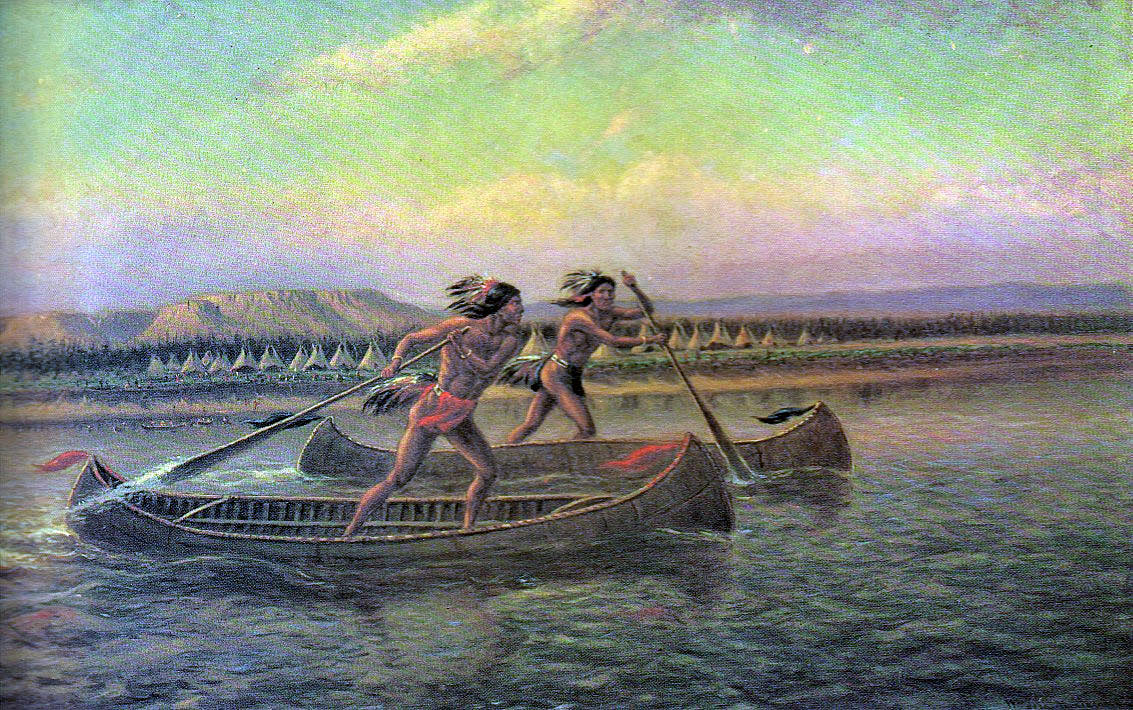
Indian canoes: Death of General Edward Braddock on the Monongahela River on 9th July 1755 in the French and Indian War
Captain Cholmley’s batman recorded: “Marched 7 miles and encamped near Turtle Creek. Light horse came up with 2 French Indians and fired after them. They ran away and rose 30 more. All escaped.”
At Fort Cumberland, Charlotte Browne recorded: “……Several who called themselves friendly Indians came to the fort but the gates were ordered to be shut. They stayed 4 hours and then went to the camp and we had not a drop of water there being no well in the fort.”
Tuesday 8th July 1755: Nineteenth Stage of the March, from Turtle Camp to Sugar Creek:
Engineer Gordon’s entry: Turtle Camp to Sugar Creek – 8 miles – Cutting, chiefly old timber and some digging – route: 4 miles very good, 2 miles through a bad defile, the rest good – camp: Open, dry, bad feeding, bad water and scarce.
Captain Cholmley’s batman recorded: “Marched 7 miles and as soon as at camp Captain Cholmley went upon the Advance party to cover the working party, 8pm before came to our ground.”
George Washington rejoined the army, arriving in a covered wagon.
Captain Orme recorded: “Camp near the Monongahela: The Quarter Master General mentioned (but not to the general) sending a detachment that night to invest the fort. Guides sent for and described the narrows. Resolved to pass the river the next day. Lieutenant Colonel Gage ordered to march before break of day with 2 companies of grenadiers and 160 rank & file of 44th and 48th, Gates’ independent company and two 6 pounders with proper guides to take post after second crossing. Quarter Master General to march at 4am with 250 men to make the road. Rest to march at 5am.”
The Officer recorded: “Marched very early. In this day’s march was a hollow way through which we were obliged to pass the greatest breadth being for at least 3 miles was about 50 yards, two very steep hills surrounding us. There we were obliged to reinforce our flanks, but the fatal stroke was reserved till next day which our superiors thought would never happen”.
A map prepared for the Ohio Company in around 1752 showing the area at the Ohio Forks (marked ‘a’) where the Company proposed to establish a fort and a town. Gist’s plantation is shown in the area ‘A, B, C’. There is reference to William Cromwell’s house. Cromwell was Christopher Gist’s son-in-law and one of the few identified members of the original settlement at the Plantation abandoned following Fort Necessity in June 1754. See Part I.
Halkett’s orders directed: “…..All the men but those who mount the picquet this night to draw their pieces and to load with fresh cartridges tomorrow at general beating and the commanding officers will be answerable to the General for any firing without application. The company of Grenadiers of the 44th and 48th Regiments to parade tomorrow at 2am at the head of their respective colours and to march from thence to the advance party and there put themselves under the command of Lt Col Gage. The men are to be completed with 24 rounds of powder and ball and are to take their knapsacks and haversacks but are to leave their tents behind. The grenadiers to march complete with officer and 70 rank & file. The officers not to take their baggage but to leave it in charge with the quartermasters of their respective regiments. The general to beat tomorrow at 4am the assembly at 5 and the troops to march immediately after.”
Wednesday 9th July 1755: Twentieth Stage of the March, from Sugar Creek to the Battlefield:
Engineer Gordon’s entry: Sugar Creek to the Battlefield – 6 miles – A little cutting, some digging – route: A bad defile for near a mile – Retreated to Gist’s before we encamped.
Captain Cholmley’s batman recorded: “Advance party marched at 2am, 2 grenadier companies and 100 battalion. Captain Cholmley commanded battalion with 2 cannon which was very troublesome to get forward before any road was cut as working party behind us. 11am came to the river after 7 miles. Some said saw Indians some none. Formed line of battle and cannon wheeled across. River 200 to 300 yards over not above knee deep. Bank 8 yards perp. Obliged to slope. 200 yards to Frazer’s plantation. 9.30am sentries posted and everything made secure. Breakfast, only 1 in 20 had anything to eat. Some men had nothing most of the day before. I milked the cow. 10.30am the working party came over. 11am the Grand Army started coming over. Cannon left with Quarter Master General. So we began our march again beating the Grenadier’s March all the way”.
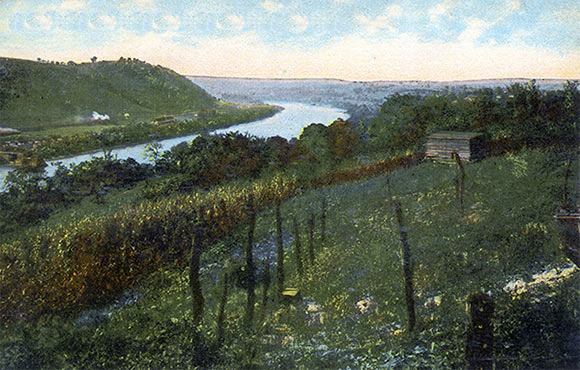
The Monongahela River in later times
Captain Orme recorded: “Whole marched as ordered. 8am the General made the first crossing, passing over 150 men in front, followed by ½ the carriages, another party of 150 men, then horses and cattle, and then the remaining troops which had possessed the heights marched over in good order. Halt and proper line of march formed. After we had moved for a mile there was a note from Lieutenant Colonel Gage that he had passed the river and posted himself as ordered. At the other crossing the bank was not yet passable and the artillery and baggage was drawn up on the beach and halted till 1pm when the General passed over a detachment of the 44th with the pickets of the right. The Artillery wagons and carrying horses passed over then detachment of 48th with left pickets which had been posted on the heights during the halt. When they had passed the General formed them. Now near 2pm. Lieutenant Colonel Gage and the Quarter Master General ordered to march until 3pm. No sooner were the pickets on their respective flanks and the word given to march but we heard an excessive and heavy firing to the front.”
Engineer Harry Gordon in a letter dated 23rd July 1755 (Pargellis) recorded: “… On the 8th we Cross’d the Long Run which was a small Rivulet that runs in to the Monongehela about 12 miles from the F: fort. We were Oblig’d to Cross it many time in the Space of two Miles, in which Distance we came along a Narrow Valley At the widest a Quarter of a Mile, very much Commanded on Both Sides By Steep hills. Iin this March Every proper precaution was taken to secure us, By Detaching all the men that cou’d Be Spar’d from the Advanced party, that day Commanded by C: Burton on our flank the General likewise order’d 350 men to take possession of the heights on East Side; & the Grenadier Company of Sir P: H[alkett’s] Regt, the Advance of the Advanc’d party, to Gain the Rising Ground, which Shut up the Valley in our front. No Enemy appear’d, & we Encamp’d on the last Mention’d Rising Ground, which Brought us within a Small Mile of the River Monongahela.”
“In our Next Days March we must Either Go along the Narrows, a very Difficult pass, on the Right Side Entirely Commanded by high ground & on the Left hemm’d in by the Monongahela; A Small Consultation was held, & it was carryied to Cross the Monongahela at the Nearer End of the Narrows, to keep along the South Side, & to Cross it again Below where turtle Creek runs in, & without the Narrows; As there was Danger Imagin’d, the 2 Compys of Grenadiers with 150 men of the two Regts Commanded By Coll: Gage were Order’d to March By 2 o’Clock of the Morning of the 9th to take possession of the Banks of the second Crossing of the River; two of the light 6 pounders were sent along with this party; the rest of our Little Army March’d at four, Cross’d peacably, & Came up with Coll: Gage about Eleven o’Clock in peaceable possession of the furthest Banks of the Last Crossing. Every one who saw these Banks, Being Above 12 feet perpendicularly high Above the Shire, & the Course of the River 300 yards Broad, hugg’d themselves with joy at our Good Luck in having surmounted our greatest Difficultys, & too hastily Concluded the Enemy never wou’d dare to Oppose us.”
The next part of ‘General Braddock’s Defeat’ describes the fatal battle on the Monongahela River in which Braddock was killed and his army decisively defeated.
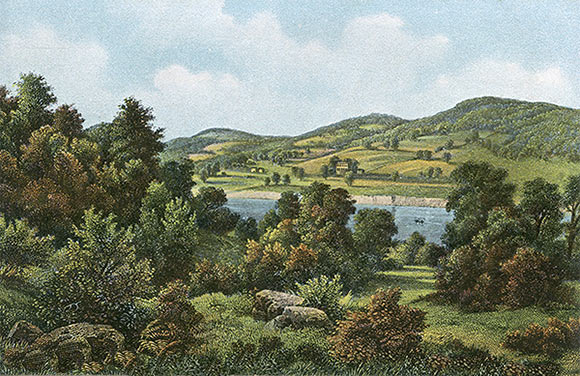
The scene of General Braddock’s defeat on the banks of the Monongahela River 9th July 1755
The previous section on Braddock’s defeat on the Monongahela in 1755 is Part 8: Braddock’s army’s march from Fort Cumberland to Little Meadows May to June 1755.
The next section on Braddock’s defeat on the Monongahela in 1755 is Part 10: Braddock’s final battle on 9th July 1755.
To the French and Indian War index
